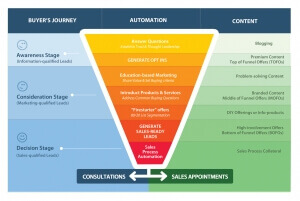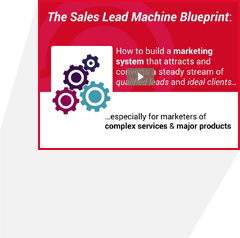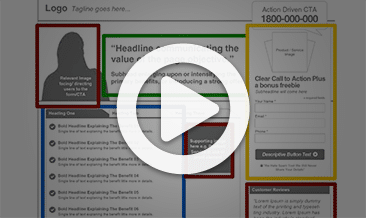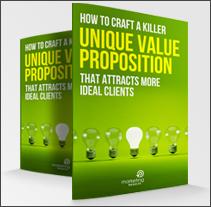
I speak with a lot of business owners and sales managers who want to shorten their sales cycles. In other words, they want to close sales sooner rather than later, and with less effort, waste and frustration.
Many salespeople are in the dark about why sales take a long time to close. Here are some of the most common reasons (i.e. excuses) I’ve heard:
- “Well in our industry, people just take a long time to make up their mind.”
- “People don’t see this as an urgent purchase, so they take their time.”
- “Our buyer typically purchases by committee, and committees take a long time to decide.”
- “We’re not selling widgets here – it takes several appointments to explain everything so they can get their head around it.”
- “This is a big ticket purchase – people won’t spend $XXX,XXX at the drop of a hat.”
In this article I’ll share with you how one client reduced their average sales cycle from 10 weeks to 10 days (with some sales happening in as few as 10 hours.)
Before we proceed, I do get that some sales are complex and aren’t going to happen overnight. If you’re selling Boeing Dreamliners to airlines, or nuclear power stations to governments, then you’re at a whole different level of complexity.
But for the majority of people selling B2B or B2C, there’s a lot here that can be “copy and pasted” into your own campaigns.
Case Study: Closing Sales In 10 Days, Not 10 Weeks
We worked with a financial planning company, who sold advice and buyers agency services to investors. Their average transaction size in the first year was between $5,000 and $20,000.
They were “keeping the lights on” – just – but were almost killing themselves bringing in new business.
Once they made a sale, their delivery process had reasonable GP (gross profit), but getting a prospect to say yes was extremely labour intensive to the point where it was making the business unviable, and certainly no fun to be in.
Here’s how the “Before” sales process looked:
- Leads were being gathered from stands at shopping centres and trade shows
- A salesperson would then contact the leads to book an in-home appointment
- Despite sending email and text message reminders, many appointments resulted in “no shows” or were otherwise not effective (e.g. because husband and wife were not at home together, or because other distractions were at play).
- Some of the in-home appointments would involve up to 3 hours travel time, round trip.
- Some sales took as many as 10 in-home appointments to close (with the risk of tipping over at any stage).
- Prospects were being “trained” to request an in-home appointment whenever they had a question or query.
- All the rushing around at the beck and call of prospects also served to de-position the advisors, who were in fact extremely qualified and knowledgeable professionals.
The only reason why this sales process functioned at all, was because the owners were doing it themselves and were prepared to put in 80-hour weeks on meagre pay to get the flywheel turning.
Certainly, this wouldn’t have worked with a salaried or commission-based sales team.
10 Strategies Used to Fix Their Sales Problem
Over an intensive period of 12 weeks, the client instituted a range of changes to their sales and marketing process. Many of these strategies are broadly applicable:
1. Shift marketing budget toward higher-value, inbound methods
The quality of your leads has a MASSIVE impact on the quality of your sales.
Shopping centre and trade show leads are typically obtained by “touting” and talking to anyone with a pulse who will fill in a form.
So it was no surprise that these leads were less-than-responsive further into the sales process.
The client shifted their marketing budget away from trade shows toward inbound marketing methods (AdWords, Facebook advertising, Content Marketing, SEO), where the prospect was actively searching for their offerings.
Marketing expert Dan Kennedy is right when he says, “Who calls whom, matters.”
If I call you about my services, you’ll tend to be more stand-offish in an, “OK, show-me-what-you’ve-got” sort of way.
But if you call me, I have more of an opportunity to act as a diagnostician, and thus have much more control over the sales process.
Of course, shifting marketing approach involved an element of risk for the client.
The shopping centres and trade shows were terribly inefficient, but they were bringing in a trickle of business.
Rather than shift in one fell swoop, the client gradually allocated budget toward digital / inbound strategies, accelerating the transfer only once the new channel was proven.
Within 12 weeks, they were no longer doing any trade shows or shopping centre displays.
2. Use education-based marketing to do the heavy lifting
Peter Drucker said, “The aim of marketing is to make selling superfluous. The aim of marketing is to know and understand the customer so well that the product or service fits him and sells itself.”
Sitting in multiple in-person appointments to explain the core features and benefits of a complex product is not the best use of salespeople’s time.
Salespeople should ideally assist with assessing fit, responding to questions, handling objections and securing commitment. (And the less “selling” your salespeople have to do, the better).
Instead of using sales meetings to do the heavy lifting, the client shifted to using White Papers and Webinars to explain their strategies and concepts.
Sales meetings then became focused on customising the strategies to the prospect’s situation, as opposed to explaining the strategies from first principles.
3. Align marketing messages with the Buyer’s Journey

The Buyer’s Journey is the process a prospect must go through before becoming your customer (see image).
Buyers progress through the stages of Awareness to Consideration to Decision, and at each of these three stages, they’re receptive to very specific types of content.
At the Awareness Stage, your content should emphasise solving the prospect’s problem or helping them achieve the result they want, largely independent of your product or service.
During the Consideration Stage, you should still show the prospect how to solve their problem or achieve their desired results, but this time showing how your product or service comes into play.
And at the Decision Stage, you’re ready to “talk turkey” about how your solution can fit the prospect’s situation and give them the result they want.
Before, our client was chewing up valuable time and resources by treating early-stage prospects as if they were already at the Decision Stage.
But by using marketing tools to get prospects to the Decision Stage, they were able to speak with much more receptive prospects – talking with far fewer people, but having dramatically more productive conversations with each one.
This is a BIG time and effort saver.
4. Shift from in-person appointments, to remote appointments
Many businesspeople say, “But we sell something expensive! No one will invest in my product until they’ve eyeballed me put a face to a name.”
Maybe, maybe not.
My experience says that remote appointments – especially in the first instance – are far more efficient AND effective than face-to-face appointments.
The client was naturally skeptical about shifting to a remote appointment model, but after a week of running the new system, they were punching themselves up for not doing it sooner.
Here are the advantages of remote appointments for the seller:
- No travel time or cost.
- Much lower risk of a missed appointment – just move on to your next task.
- Less de-positioning – you’re no longer traipsing out, cap-in-hand, to visit the prospect on “their turf”
- Easier to structure your presentation, with fewer ways to be side-tracked
- Fewer distractions
- Easier to re-schedule at short notice
Here are more advantages of remote appointments for the prospect:
- No need to have an unknown person in your home/office
- No need to be at home/in the office when the salesperson calls
- No fear of, “how do we get this guy out of our home/office if we don’t want what he’s selling?”
- Lower perceived commitment – easier to say “yes” to
But what if prospect insists on meeting face to face?
This is usually a good thing – it shows they’re prepared to invest time, focus and effort in the relationship.
The way I would recommend doing this, is to make the first appointment by phone to assess fit, then if a face-to-face meeting makes sense after that, meeting at your place, not theirs (who visits whom matters, too).
5. Use “division of labour” in the sales process to free up scarce resources

Many studies have shown conclusively that most salespeople spend very little time actually selling – that is, prosecuting sales opportunities.
The rest of their time is spent on tasks such as: project management, customer service, opportunity management, clerical tasks, social activities and prospecting.
Certainly, this was the case for our client. Their advisors were working 80 hour weeks, but they were lucky if more than 8 of those hours were spent sitting in front of prospects, selling.
What they did, was to apply a division of labour and shift responsibility for all non-sales functions to another role, called a Sales Co-ordinator.
Then all the salesperson had to do, was rock up to pre-booked sales calls and sell.
(This division-of-labour principle has been written about extensively by Justin Roff-Marsh of Ballistix – here’s a great primer article).
6. Insist on standards of behaviour from prospects
Before, when the salesperson travelled 90 minutes through rush hour traffic to get to an appointment, and the prospect’s wife wasn’t there as agreed, the salesperson was in a quandary…
(He knew that unless both partners were present during a sales meeting, a decision couldn’t be made. And yet, a 3-hour round trip had already been expended, representing a large “sunk cost” to the salesperson.)
So what would usually happen, is that the salesperson would acquiesce and end up speaking with just one partner, with predictable results – they couldn’t make a decision.
With the new model, the client would provide instructions to the prospect that BOTH partners were to be present on the call.
If only one partner showed, up, the call would be stopped or rescheduled (and with much less effort than before).
7. Add structure to your sales process
Many salespeople rely on a somewhat unstructured sales presentation. They start talking, then “see where the conversation goes”.
That was what our client was doing.
This rarely works as well as having a structured sales process that is designed to lead the prospect from one stage to the next.
The client converted their sales process into a structured Powerpoint presentation, that could be presented to the prospect via a screen sharing application called Join.me.
By doing this, they were able to standardise their sales presentation, resulting in an improved close rate. And by working off a standard process, they had a better platform to test new things in order to continuously improve results.
8. Provide prospects with a clear path to purchase
Have you ever been interested in buying something, and you said to the salesperson, “OK, so what’s the next step?”… only to hear the salesperson present you with a convoluted explanation that still left you wondering how to give them your money?
The sale is already complex. There’s no need to inject extra complexity.
One way to remove complexity is to “productise” a complex service into one of several easily-understandable packages (e.g. Bronze, Silver, Gold).
By productising their service into three levels, the client was able to completely do away with a lengthy proposal-generation process and provide the prospect with an easy choice.
9. Stay in control of the next steps
Related to the above point: someone is always in control of the sales process. And if that someone is not you as the seller, it must be the buyer.
One of the ways salespeople lose control of the buying process is by not being clear and certain about the next steps.
In the case of our client, they instituted a policy of always clarifying the next step before the current step ended.
So instead of saying “let’s get in touch next week”, they would calendar an appointment to follow up at a specific time and date.
Instead of emailing a proposal and hoping the prospect read it and responded, they would set specific appointments to present the proposal in “real time”.
10. Take responsibility for managing the urgency of the sale
Statements like, “the prospect just tends to make a decision in their own time” or “People take 3 months to make a decision in our industry” contain an element of self-fulfilling prophecy.
One of the reasons why prospects take a long time to decide is that the sales process itself is not supportive of fast decision-making (see points 7, 8 and 9 above).
Another reason is that the prospect herself is not feeling a sense of urgency to commit.
There may be legitimate reasons for this… but more often than not, the salesperson can have significant influence on urgency perception and speed of purchase.
If your product solves the prospect’s problem, do they want that problem gone NOW, or later?
If your product delivers specific desired results, to they want those results IMMEDIATELY, or later?
How you structure the entire sales process is going to influence speed of purchase at the end.
You won’t get every buyer to buy immediately, but you can reduce average decision making time if you take responsibility for urgency.
Here’s what the “After” sales process looked like:
- Average sales meetings reduced from 10 in-person meetings to 2.5 meetings (mostly phone-based).
- Zero in-person meetings at prospect’s home or place of business – all prospects coming to them where an in-person meeting took place
- Marketing cost per sale reduced by ~50% (with salesperson hours reduced by over 80%)
- Average sales cycle reduced from 70 days to 10 days (with some as quick as 10 hours).
- Salespeople cut 30+ hours of non-productive time per week from their schedules
These changes took 12 weeks to come about, with further refinements being made over the next 12 weeks.
Even the client was surprised:
“Where we were 8 weeks ago, to where we are today, is not even on the same planet. 12 weeks ago, we were trying to cut down from 10 meetings, and we couldn’t see how it could go to fewer than 7”
The resulting sales process, containing 2 or 3 meetings, was a pleasant surprise.
And the best part is, most of the techniques above are broadly applicable to all sales processes. Give them a go and let me know how you get on. And if you want a hand applying these concepts in your organisation on a “done for you” basis, get in touch to discuss if this is a match for your situation.
Want more lead generation and sales strategies? Check out our free video training series:

What other ideas have you tried for increasing the speed of sale and how have they worked?




